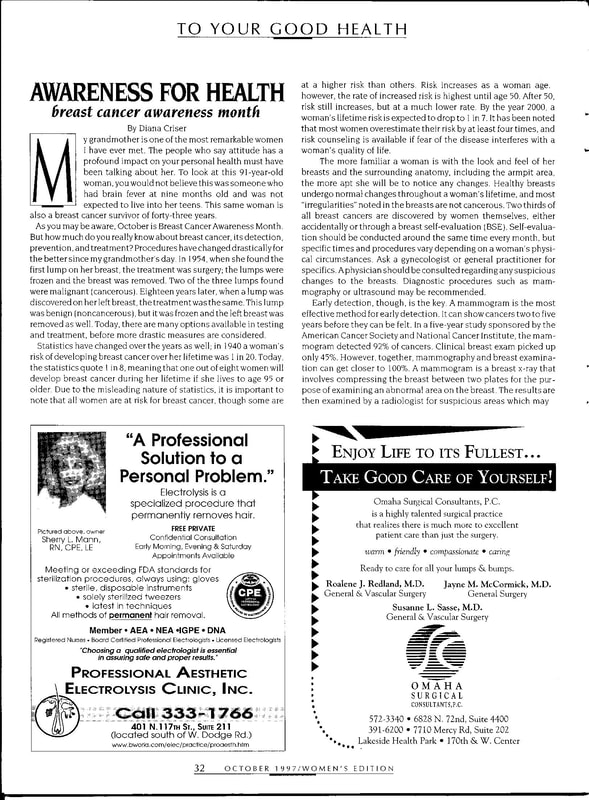To Your Good Health - October 1997AWARENESS FOR HEALTH: BREAST CANCER AWARENESS MONTHBy Diana L. Criser |
| ||

y grandmother is one of the most remarkable women I have ever met. The people who say that attitude has a profound impact on your personal health must have been talking about her. To look at this 91 year old woman, you would not believe that this was someone who had brain fever at nine months old and was not expected to live into her teens. This same woman is also a breast cancer survivor of forty-three years.
As you may be aware, October is Breast Cancer Awareness Month. But how much do you really know about breast cancer, its detection, prevention, and treatment? Procedures have changed drastically for the better since my grandmother's day. In 1954, when she found the first lump in her right breast, the treatment was surgery; the lumps were frozen and the breast was removed. Two of the three lumps found were malignant (cancerous). Eighteen years later, when a lump was discovered in her left breast, the treatment was the same. This lump was benign (non-cancerous), but it was frozen and the left breast was removed as well. Today, there are many options available in testing and treatment, before more drastic measures are considered.
Statistics have changed over the years as well; in 1940 a woman's risk of developing breast cancer over her lifetime was 1 in 20. Today, the statistics quote 1 in 8, meaning that one out of eight women will develop breast cancer during her lifetime if she lives to age 95 or older. Due to the misleading nature of statistics, it is important to note that all women are at risk for breast cancer, though some are at a higher risk than others. Risk increases as a woman ages; however, the rate of increased risk is highest until age 50. After 50, risk still increases, but at a much lower rate. By the year 2000, a woman's lifetime risk is expected to drop to 1 in 7. It has been noted that most women overestimate their risk by at least four times, and risk counseling is available if fear of the disease interferes with a woman's quality of life.
The more familiar a woman is with the look and feel of her breasts and the surrounding anatomy, including the armpit area, the more apt she will be to notice any changes. Healthy breasts undergo normal changes throughout a woman's lifetime, and most "irregularities" noted in the breasts are not cancerous. Two thirds of all breast cancers are discovered by women themselves, either accidentally or through a breast self-evaluation (BSE). Self-evaluation should be conducted around the same time every month, but specific times and procedures vary depending on a woman's physical circumstances. Ask a gynecologist or general practitioner for specifics. A physician should be consulted regarding any suspicious changes to the breasts; diagnostic procedures such as a mammography or ultrasound may be recommended.
Early detection, though, is the key. A mammogram is the most effective method for early detection. it can show cancers two to five years before they can be felt. In a five year study sponsored by the American Cancer Society and National Cancer Institute, the mammogram detected 92% of cancers while the clinical breast exam picked up only 45%. However, together, a mammography and breast examination can get closer to 100%. A mammogram is a breast x-ray that involves compressing the breast between two plates for the purpose of examining an abnormal area on the breast. The results are then examined by a radiologist for suspicious areas which may require further testing or follow up. Mammography carries a 10 to 15% false negative rate, and only one fifth of all abnormalities found on mammograms turn out to be cancerous.
When is the best age to begin receiving routine mammograms? Although the subject of debate over the last year, the American Cancer Society recently issued their official recommendations. A woman should receive a "base line" mammogram at the age of 40, and then receive a routine mammogram every year thereafter. The baseline is used for exam comparison in subsequent years. A mammogram is also essential for a woman of any age with symptoms such as breast lumps or dimpling.
Ultrasound, or sonography, another tool in early detection, uses sound waves to help distinguish a harmless, liquid-filled lesion or cyst from a solid tumor in the breast. The sound waves pass through a cyst, but bounce off of a solid mass. If a solid lump is found, a biopsy is usually recommended.
A biopsy removes a sample of suspicious tissue or cells in the breast for examination by a pathologist. A needle or incision can be used to remove the sample, and most biopsies can be performed using local anesthetic on an out-patient basis. Some biopsy procedures also use ultrasound as a guidance tool during the removal procedure.
A new advancement called Advanced Breast Biopsy Instrumentation, or ABBI, creates a computer-generated, digitally-enhanced image of the biopsy area. This new device determines the biopsy location within one millimeter, requiring less breast tissue to be removed. The breast undergoes less trauma, and the recuperation time is much shorter than with more traditional biopsy procedures. For more information regarding the new ABBI procedure and other breast cancer issues, call the National Cancer Institute's Cancer Information Service toll free at 1-800-4-CANCER.
So put on your pink ribbon and expand your awareness of breast cancer detection, prevention and treatment options. Early detection is the best approach - there is a 96% survival rate when detection occurs early. This early detection can result in saving, not losing, a breast. Treatment with "lumpectomy" and radiotherapy in early breast cancer is as effective as mastectomy. Utilizing self-examination, routine mammography and specialized breast ultra sound you can rid yourself of your anxiety and fears about breast cancer. There is no better time to start than during Breast Cancer Awareness Month.
As you may be aware, October is Breast Cancer Awareness Month. But how much do you really know about breast cancer, its detection, prevention, and treatment? Procedures have changed drastically for the better since my grandmother's day. In 1954, when she found the first lump in her right breast, the treatment was surgery; the lumps were frozen and the breast was removed. Two of the three lumps found were malignant (cancerous). Eighteen years later, when a lump was discovered in her left breast, the treatment was the same. This lump was benign (non-cancerous), but it was frozen and the left breast was removed as well. Today, there are many options available in testing and treatment, before more drastic measures are considered.
Statistics have changed over the years as well; in 1940 a woman's risk of developing breast cancer over her lifetime was 1 in 20. Today, the statistics quote 1 in 8, meaning that one out of eight women will develop breast cancer during her lifetime if she lives to age 95 or older. Due to the misleading nature of statistics, it is important to note that all women are at risk for breast cancer, though some are at a higher risk than others. Risk increases as a woman ages; however, the rate of increased risk is highest until age 50. After 50, risk still increases, but at a much lower rate. By the year 2000, a woman's lifetime risk is expected to drop to 1 in 7. It has been noted that most women overestimate their risk by at least four times, and risk counseling is available if fear of the disease interferes with a woman's quality of life.
The more familiar a woman is with the look and feel of her breasts and the surrounding anatomy, including the armpit area, the more apt she will be to notice any changes. Healthy breasts undergo normal changes throughout a woman's lifetime, and most "irregularities" noted in the breasts are not cancerous. Two thirds of all breast cancers are discovered by women themselves, either accidentally or through a breast self-evaluation (BSE). Self-evaluation should be conducted around the same time every month, but specific times and procedures vary depending on a woman's physical circumstances. Ask a gynecologist or general practitioner for specifics. A physician should be consulted regarding any suspicious changes to the breasts; diagnostic procedures such as a mammography or ultrasound may be recommended.
Early detection, though, is the key. A mammogram is the most effective method for early detection. it can show cancers two to five years before they can be felt. In a five year study sponsored by the American Cancer Society and National Cancer Institute, the mammogram detected 92% of cancers while the clinical breast exam picked up only 45%. However, together, a mammography and breast examination can get closer to 100%. A mammogram is a breast x-ray that involves compressing the breast between two plates for the purpose of examining an abnormal area on the breast. The results are then examined by a radiologist for suspicious areas which may require further testing or follow up. Mammography carries a 10 to 15% false negative rate, and only one fifth of all abnormalities found on mammograms turn out to be cancerous.
When is the best age to begin receiving routine mammograms? Although the subject of debate over the last year, the American Cancer Society recently issued their official recommendations. A woman should receive a "base line" mammogram at the age of 40, and then receive a routine mammogram every year thereafter. The baseline is used for exam comparison in subsequent years. A mammogram is also essential for a woman of any age with symptoms such as breast lumps or dimpling.
Ultrasound, or sonography, another tool in early detection, uses sound waves to help distinguish a harmless, liquid-filled lesion or cyst from a solid tumor in the breast. The sound waves pass through a cyst, but bounce off of a solid mass. If a solid lump is found, a biopsy is usually recommended.
A biopsy removes a sample of suspicious tissue or cells in the breast for examination by a pathologist. A needle or incision can be used to remove the sample, and most biopsies can be performed using local anesthetic on an out-patient basis. Some biopsy procedures also use ultrasound as a guidance tool during the removal procedure.
A new advancement called Advanced Breast Biopsy Instrumentation, or ABBI, creates a computer-generated, digitally-enhanced image of the biopsy area. This new device determines the biopsy location within one millimeter, requiring less breast tissue to be removed. The breast undergoes less trauma, and the recuperation time is much shorter than with more traditional biopsy procedures. For more information regarding the new ABBI procedure and other breast cancer issues, call the National Cancer Institute's Cancer Information Service toll free at 1-800-4-CANCER.
So put on your pink ribbon and expand your awareness of breast cancer detection, prevention and treatment options. Early detection is the best approach - there is a 96% survival rate when detection occurs early. This early detection can result in saving, not losing, a breast. Treatment with "lumpectomy" and radiotherapy in early breast cancer is as effective as mastectomy. Utilizing self-examination, routine mammography and specialized breast ultra sound you can rid yourself of your anxiety and fears about breast cancer. There is no better time to start than during Breast Cancer Awareness Month.


